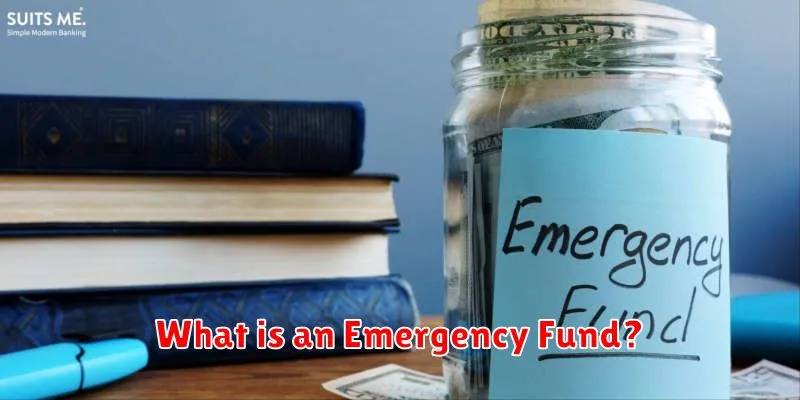Building a robust emergency fund is paramount for achieving financial stability. Unexpected events, from job loss to medical emergencies, can significantly impact your finances. A well-funded emergency fund acts as a crucial safety net, protecting you from falling into debt and enabling you to navigate unforeseen circumstances with greater financial security and peace of mind. This article will explore the vital importance of an emergency fund and provide practical strategies for building and maintaining one.
What is an Emergency Fund?

An emergency fund is a savings account specifically designed to cover unexpected expenses. It acts as a financial safety net, protecting you from dipping into debt or disrupting your regular budget when unforeseen circumstances arise.
These unexpected expenses can range from medical bills and home repairs to job loss and car troubles. The goal is to accumulate enough money to cover 3-6 months of essential living expenses.
Unlike other savings goals, such as a down payment on a house or retirement, the emergency fund’s primary purpose is liquidity. The money should be readily accessible in a high-yield savings account or similar easily accessible account, allowing for quick access in times of need.
Establishing an emergency fund is a crucial step towards achieving long-term financial stability, providing peace of mind and protecting your financial well-being against life’s unpredictable events.
How Much Should You Save?
The general recommendation is to have 3-6 months’ worth of living expenses saved in an emergency fund. This amount provides a cushion to cover unexpected costs like medical bills, job loss, or home repairs.
However, the ideal amount depends on your individual circumstances. Higher earners may feel more comfortable with a larger emergency fund, perhaps 6-12 months’ worth of expenses. Those with unstable income or high debt might aim for the higher end of the range or even more.
Consider your personal risk tolerance and financial obligations when determining the appropriate size of your emergency fund. It’s better to overestimate than underestimate, prioritizing financial security.
Start small if needed. Even saving a little each month contributes to building a crucial safety net. Focus on consistently adding to your fund over time.
Where to Keep Your Emergency Fund

Your emergency fund should be readily accessible yet still offer some level of security. High-yield savings accounts are generally the best option. They offer better interest rates than traditional savings accounts while maintaining easy access to your funds. Avoid accounts with fees that will diminish your savings.
Money market accounts (MMAs) are another suitable choice. They often provide slightly higher interest rates than savings accounts and may offer check-writing or debit card access. However, interest rates can fluctuate.
While certificates of deposit (CDs) offer potentially higher returns, they often involve penalties for early withdrawals, making them unsuitable for emergency funds which need to be immediately accessible.
It’s crucial to choose an institution you trust and which offers FDIC insurance to protect your savings up to $250,000 per depositor, per insured bank, for each account ownership category.
Ultimately, the best place to keep your emergency fund is somewhere that prioritizes liquidity and security, allowing you to access your funds quickly and safely when unforeseen circumstances arise.
Steps to Start an Emergency Fund
Establishing an emergency fund is a crucial step towards achieving financial stability. Begin by defining your financial goals and determining a realistic savings target. A common recommendation is to save 3-6 months’ worth of living expenses.
Next, track your spending to identify areas where you can cut back. This will help you allocate more funds towards your emergency fund. Consider using budgeting apps or spreadsheets to monitor your income and expenses effectively.
Once you have a clear understanding of your spending habits, automate your savings. Set up automatic transfers from your checking account to your savings account on a regular basis, even if it’s a small amount. Consistency is key.
Choose a high-yield savings account or a similar low-risk investment vehicle to maximize your returns while ensuring accessibility to your funds in case of an emergency. Avoid investments with higher risk that might hinder your access to funds during a crisis.
Finally, review and adjust your savings plan regularly. Life circumstances change, so periodically reassess your target amount and savings rate to ensure your emergency fund remains adequate to cover unexpected events.
How to Grow Your Emergency Savings
Building a robust emergency fund is crucial for financial stability. To effectively grow your savings, start by setting a realistic goal. Aim for 3-6 months’ worth of living expenses. This provides a buffer against unexpected events like job loss or medical emergencies.
Next, create a budget and identify areas where you can cut back on spending. Even small reductions can make a significant difference over time. Automate your savings by setting up automatic transfers from your checking account to your savings account each month. This ensures consistent contributions without requiring constant effort.
Consider increasing your income through a side hustle or seeking a higher-paying job. Every extra dollar earned can be directed towards your emergency fund, accelerating its growth. Finally, regularly review your progress and adjust your savings plan as needed. Maintaining consistent discipline is key to achieving your financial goals.
Remember, consistency is key. Even small contributions made regularly will add up significantly over time. Prioritizing your emergency fund is a proactive step towards securing your financial future and mitigating the impact of unforeseen circumstances.
The Role of Insurance in Financial Stability
Insurance plays a vital role in bolstering financial stability by mitigating the impact of unforeseen events. A robust insurance portfolio acts as a safety net, protecting against significant financial losses from various sources.
Health insurance shields individuals and families from crippling medical expenses, preventing debt accumulation during illness or injury. Homeowners and auto insurance safeguard against property damage and liability claims, protecting significant assets. Life insurance provides financial security for dependents in the event of the policyholder’s death.
By transferring the risk of financial hardship to insurance companies, individuals and families can maintain financial stability even when facing unexpected challenges. This reduces the reliance on emergency funds alone, providing a crucial layer of protection in a comprehensive financial plan.
When to Use Your Emergency Fund

Your emergency fund is designed for unexpected, unforeseen events that disrupt your financial stability. It’s a safety net, not a piggy bank for discretionary spending.
Appropriate uses include unanticipated medical expenses (e.g., high deductibles, unexpected illnesses), sudden job loss resulting in lost income, major home repairs (e.g., roof damage, plumbing issues), and emergency travel related to unforeseen family circumstances.
Essentially, you should tap into your emergency fund when facing a financial crisis that threatens your ability to meet essential living expenses. Before using it, carefully assess the situation to ensure the expense is truly an emergency and not a planned purchase.
It’s crucial to remember that replenishing your emergency fund after use is paramount. Aim to rebuild it to your target amount as quickly as possible to maintain your financial security.
Rebuilding an Emergency Fund After Use
Once your emergency fund has been used, rebuilding it is crucial for maintaining financial stability. The speed of rebuilding depends on your financial situation and the amount depleted.
Prioritize consistent contributions. Even small, regular deposits will add up over time. Consider automating savings transfers from your checking account to your emergency fund for effortless saving.
Identify areas where you can reduce expenses. Analyze your spending habits to find areas to cut back, like dining out or entertainment subscriptions. These savings can be redirected towards rebuilding your fund.
Explore additional income streams if necessary. This could involve a part-time job, selling unused items, or taking on freelance work. Supplementing your income will accelerate your fund’s recovery.
Remember, the goal is to reach your target emergency fund balance as quickly as possible while maintaining a comfortable lifestyle. A well-funded emergency fund offers significant peace of mind and protects against unexpected financial setbacks.

